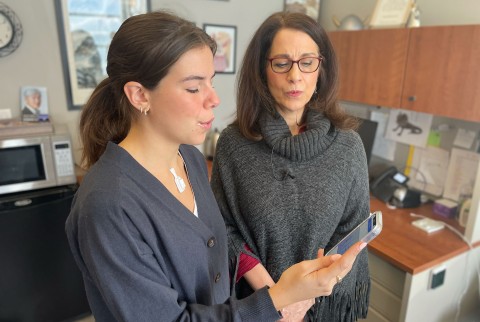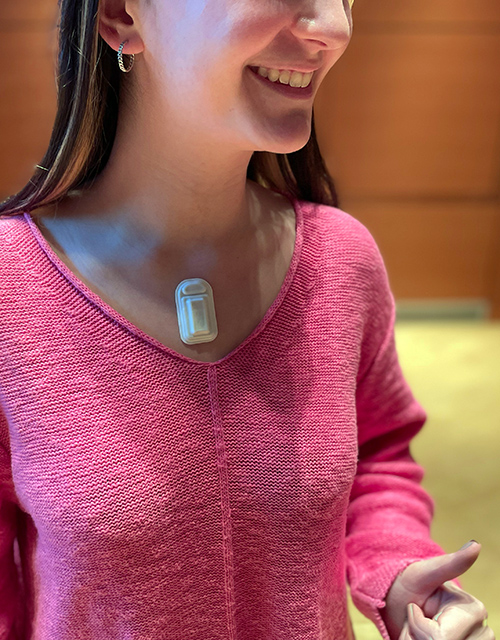
1st wearable gadget for vocal tiredness senses when your voice desires a break
Table of Contents
Deficiency of recognition is the underlying issue. Men and women rarely make the relationship between vocal functions and how people pursuits affect their voices. While one particular in 13 U.S. adults have knowledgeable vocal fatigue, most men and women never recognize they are overusing their voices until finally hoarseness presently has established in.
“What qualified prospects people into difficulties is when gatherings stack up,” Brancaccio said. “They could have rehearsals, instruct lessons, communicate during class conversations and then go to a loud party, where by they have to yell more than the track record noise. Then, toss a chilly or sickness into the mix. People have no strategy how a great deal they are coughing or clearing their throats. When these occasions stack up for days, that can put big anxiety on the voice.”
Cross-disciplinary link
As an advocate for vocal well being, Brancaccio has put in decades checking out strategies to hold her learners conscious of how much they use their voices. In 2009, she challenged her learners to keep a paper budget — physically crafting down each individual time they spoke, sang and drank water, between other items. About 10 several years later, she transformed the process into Singer Savvy, an application that features a customized vocal spending plan for each individual person and helps customers keep inside that price range.
Independently, Rogers, in collaboration with scientists at the Shirley Ryan AbilityLab, experienced formulated a wi-fi wearable device to keep track of swallowing and speech in stroke sufferers. The bandage-like sensor actions swallowing abilities and speech designs to monitor stroke patients’ recovery procedures. In the early months of the COVID-19 pandemic, Rogers’ team modified the technological innovation to check coughing, as a important symptom of the sickness.
“I required to get much more facts and make our tracking process additional specific and more correct,” Brancaccio claimed. “So, I attained out to John to see if his sensors could assistance us get extra information and facts.”
“I imagined it was a great possibility for us to lengthen our technologies over and above our really significant, but narrowly focused, works by using in health care to one thing that may possibly capture a broader populace of buyers,” Rogers explained. “Anyone who takes advantage of their voice extensively could benefit.”
The pair also partnered with speech pathologist and voice specialist Aaron M. Johnson to check out how the products could be made use of to appraise and watch therapy for individuals with vocal ailments. Johnson, who co-directs the NYU Langone’s Voice Heart, mentioned the compact, wi-fi gadget could enable monitor patients’ voices in the authentic earth — outside the house of a medical placing.
“A crucial component of voice remedy is helping folks adjust how — and how a lot — they use their voice,” claimed Johnson, review co-author and associate professor in the office of otolaryngology at NYU Grossman University of Medication. “This gadget will allow individuals and their clinicians to recognize voice use styles and make changes in vocal demand to lessen vocal exhaustion and pace restoration from voice ailments. Generalizing vocal tactics and workouts from treatment sessions into day-to-day existence is a single of the most challenging elements of voice treatment, and this gadget could significantly enhance that procedure.”
Singer-educated algorithms
The staff modified Rogers’ current products to exactly evaluate vocal load over time. That incorporates frequency, quantity, amplitude, duration and time of day. Like Rogers’ past devices for COVID-19 and stroke individuals, the new system also senses vibrations fairly than recording audio. This allows the unit to detect vocal activity exactly from the user, somewhat than the ambient noise encompassing them.
The greatest obstacle was to create algorithms capable of distinguishing talking from singing. To conquer this problem, Brancaccio recruited voice and opera students to undertake a wide variety of singing workouts to teach the equipment-understanding algorithms. A staff of classical singers with different vocal ranges — various from bass to soprano — wore the units when buzzing, singing staccato scales and songs, reading and additional. Each and every singer generated 2,500 a person-2nd-prolonged home windows of singing and 2,500 a person-second-prolonged home windows of talking.
95%
Accuracy of algorithms when distinguishing singing from talking
The ensuing algorithm can separate singing from talking with extra than 95% precision. And, when applied in a choir placing, the machine captures only details from the wearer and not sounds from close by singers.
“Prolonged conversing is one of the most fatiguing pursuits for people who are teaching to develop into professional singers,” Brancaccio explained. “By separating singing and talking, it can help individuals establish additional consciousness all over how substantially they are talking. There is evidence that even brief 15- to 20-minute periods of total silence interspersed throughout the working day can aid vocal fold tissues recover and restore.”
How to use it
To use the unit, the wearer basically adheres it to the sternum, beneath the neck, and syncs the system with the accompanying application. Rogers’ team presently is functioning on a strategy to personalize vocal budgets for just about every user. Listed here, users will press a button in the app if they practical experience vocal irritation at any stage all through the working day, properly capturing the instantaneous and cumulative vocal load at the time. These information can serve as a personalised threshold for vocal exhaustion. When the consumer nears or exceeds their customized threshold, a haptic unit will vibrate as an alert.
Bienen pupil Madeleine Zuckerman wears the product in Brancaccio’s opera course.
Identical in sizing and sort to a wristwatch, this haptic product involves several motors that can activate in various styles and with different ranges of depth to express distinct messages. People also can keep track of a graphical show in the app, which splits information and facts into speaking and singing groups.
“It makes use of Bluetooth, so it can chat to any product that has a haptic motor embedded,” Rogers stated. “So, you don’t have to use our wristband. You could just leverage a normal good view for haptic responses.”
Despite the fact that other vocal-checking gadgets do exist, these use significant collars, tethering wires and bulky tools. Some also use embedded microphones to seize audible vocal knowledge, foremost to privacy fears.
“Those do not perform for ongoing checking in a real natural environment,” Brancaccio stated. “Instead of putting on cumbersome, wired tools, I can stick on this delicate, wearable system. After it is on, I don’t even discover it. It’s super mild and quick.”
What’s upcoming
Since Rogers’ former products capture body temperature, coronary heart charges and respiratory activity, the researchers integrated all those abilities in the vocal-monitoring unit. They believe that these added details will assist to explore elementary exploration thoughts relating to vocal tiredness.
“This is more speculative, but it could possibly be intriguing to see how physical exercise impacts vocal tiredness,” Rogers mentioned. “If someone is dancing whilst singing, is that more stress filled on the vocal folds in comparison to a person who is not physically exerting them selves? Those people are the kinds of queries we can question and quantitatively solution.”
In the meantime, Brancaccio is energized for her learners to have a instrument that can assist stop personal injury. She hopes others — together with non-singers — will see the profit to retaining their vocal cords healthful.
“Your voice is section of your identification — regardless of whether you are a singer or not,” she stated. “It’s integral to each day lifestyle, and it is well worth preserving.”
The review, “Closed-loop community of skin-interfaced wireless products for quantifying vocal exhaustion and offering person feedback,” was supported by the Querrey Simpson Institute for Bioelectronics at Northwestern College.
